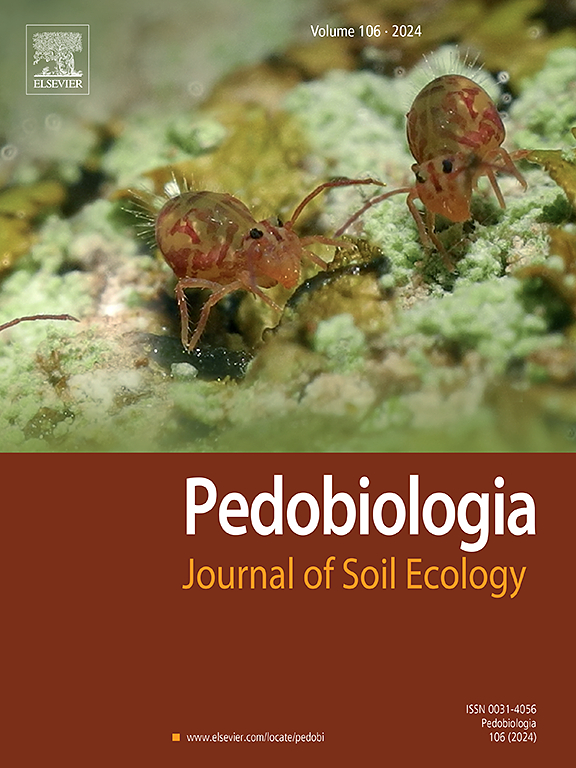Assessment of soil feeding activity using different bait materials for the bait-lamina test: A small-scale study in Eucalyptus blocks
IF 2.2
3区 农林科学
Q3 ECOLOGY
引用次数: 0
Abstract
A standard bait material (consisting of cellulose powder, wheat bran and activated charcoal) has been proposed for the bait-lamina test, however, several studies have deviated from using this. It is unclear whether different bait materials deliver similar, comparable results. In a small-scale, field-based study, we compared three baits namely oat bran, nettle (Urtica dioica) and jelly (i.e. Jell-O) to the standard wheat bran bait. Sites, with high environmental variation between them, were selected in mature, cleared and naturally recovering Eucalyptus grandis blocks located in the Western Cape, South Africa. Contrary to previous research, we found soil feeding activity fluctuated across the soil profile instead of progressively decreasing with soil depth, which can potentially be attributed to the soil’s dry and hot summer conditions. Our results indicate that wheat bran remains the most effective bait with the bait-lamina test. Compared to the standard wheat bran bait, the nettle bait presented the lowest estimates of feeding activity across all sites, while the jelly bait showed similar levels of soil feeding activity within each block. Therefore, the nettle bait cannot be recommended as a bait material, while the jelly bait could serve as an adequate proxy for the wheat bran bait. These results are particularly important for small-scale studies, such as the present study, to obtain snapshots of potential bait preferences. However, more research on bait preference is required by conducting larger-scale studies across different systems, climatic regions and environmental conditions in order to understand the relationship between soil organisms and their feeding activity when offered different bait materials.
评估不同饵料在饵料层试验中的土壤摄食活性:桉树小区的小规模研究
一种标准的诱饵材料(由纤维素粉、麦麸和活性炭组成)已经被提议用于诱饵层试验,然而,一些研究已经偏离了使用这种材料。目前尚不清楚不同的诱饵材料是否会产生类似的、可比较的结果。在一项小规模的实地研究中,我们将燕麦麸、荨麻(荨麻)和果冻(即Jell-O)三种诱饵与标准麦麸诱饵进行了比较。场地之间的环境差异很大,选择在位于南非西开普省的成熟、清理和自然恢复的大桉树块中。与以往的研究相反,我们发现土壤摄食活动在整个土壤剖面上波动,而不是随着土壤深度逐渐减少,这可能归因于土壤的干燥和炎热的夏季条件。实验结果表明,麦麸仍是最有效的饵料。与标准麦麸饵料相比,荨麻饵料在所有地点呈现出最低的摄食活性,而果冻饵料在每个区域显示出相似的土壤摄食活性。因此,不能推荐荨麻饵料作为饵料,而果冻饵料可以作为麦麸饵料的合适替代品。这些结果对于小规模研究,如本研究,获得潜在诱饵偏好的快照尤为重要。然而,在不同的系统、气候区域和环境条件下,需要进行更大规模的饵料偏好研究,以了解不同饵料条件下土壤生物及其摄食活动之间的关系。
本文章由计算机程序翻译,如有差异,请以英文原文为准。
求助全文
约1分钟内获得全文
求助全文
来源期刊

Pedobiologia
环境科学-生态学
CiteScore
4.20
自引率
8.70%
发文量
38
审稿时长
64 days
期刊介绍:
Pedobiologia publishes peer reviewed articles describing original work in the field of soil ecology, which includes the study of soil organisms and their interactions with factors in their biotic and abiotic environments.
Analysis of biological structures, interactions, functions, and processes in soil is fundamental for understanding the dynamical nature of terrestrial ecosystems, a prerequisite for appropriate soil management. The scope of this journal consists of fundamental and applied aspects of soil ecology; key focal points include interactions among organisms in soil, organismal controls on soil processes, causes and consequences of soil biodiversity, and aboveground-belowground interactions.
We publish:
original research that tests clearly defined hypotheses addressing topics of current interest in soil ecology (including studies demonstrating nonsignificant effects);
descriptions of novel methodological approaches, or evaluations of current approaches, that address a clear need in soil ecology research;
innovative syntheses of the soil ecology literature, including metaanalyses, topical in depth reviews and short opinion/perspective pieces, and descriptions of original conceptual frameworks; and
short notes reporting novel observations of ecological significance.
 求助内容:
求助内容: 应助结果提醒方式:
应助结果提醒方式:


